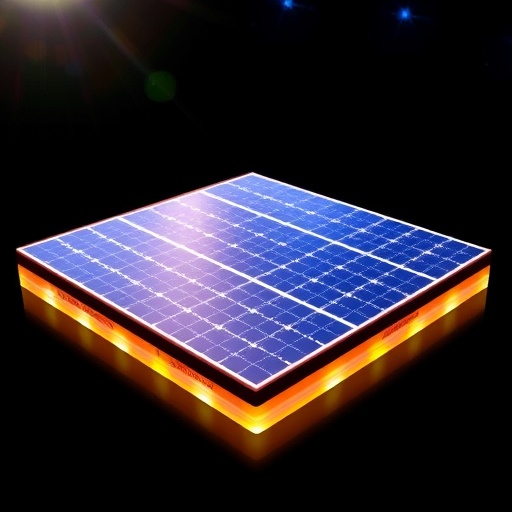In a groundbreaking achievement, researchers led by Professors Zhigang Li from Taizhou University and Bingqing Wei from the University of Delaware have shattered the long-held Shockley–Queisser efficiency limit for single-junction photovoltaic cells. This revolutionary development has resulted in silicon solar cells operating with an exceptional power conversion efficiency (PCE) ranging between 50% and 60% under low-temperature conditions, specifically at operating temperatures between 30 K and 50 K. This dramatic advancement paves the way for new applications in cryogenic environments, including potential use in deep space exploration and lunar missions.
For over six decades, the 33% Shockley–Queisser limit has been perceived as an insurmountable barrier to efficiency for traditional photovoltaic technologies. Nonetheless, the breakthrough achieved by the research team marks a monumental leap forward, essentially doubling the existing efficiency records at room temperature. The ramifications of harnessing such efficiency at low temperatures can redefine our approach to solar energy generation, particularly in extreme environments where conventional technologies have struggled to perform.
The key to this technological leap relies heavily on innovative design and management techniques that address challenges presented by low temperatures. Traditional silicon-based solar cells exhibit what is known as the “freeze-out paradox,” where semiconductor carriers become immobilized below approximately 150 K, resulting in performance degradation. Contrary to the previous notion that lower temperatures are inherently beneficial for photovoltaic performance, the findings from this research illustrate that there is a complex interplay of thermal dynamics at play in these low-temperature settings.
Thermal-loss suppression mechanisms are a major factor contributing to enhanced performance in the newly developed silicon cells. When operating in low-temperature conditions, the phonon population significantly decreases, leading to a reduction in hot-carrier cooling effects. Consequently, the open-circuit voltage (Voc) of these novel cells can approach the band-gap energy, signifying a more efficient energy harvesting process. This aligns perfectly with the demands of advanced applications often found in space and quantum technologies.
The innovative strategies employed in this research go beyond merely mitigating issues associated with low temperatures; they actively transform potential challenges into opportunities for optimization. A prime example of this is the implementation of cryogenic hot-carrier management techniques. These techniques involve sophisticated laser lines that are specifically tuned above the energy gap to generate mobile photocarriers. By doing so, these photocarriers can outpace the cooling of the lattice, increasing the voltage output and enhancing overall efficiency levels.
Another compelling feature of this advancement is the utilization of impact-ionization boost processes, which unlock new levels of efficiency at sub-50 K temperatures. The research demonstrates that under low temperatures, conservation rules around momentum lose their strict applicability. Photons in the region of approximately 980 nm can instigate multiple-exciton generation, pushing external quantum efficiency (EQE) beyond an unprecedented threshold of 140%. This represents a significant advancement in photon-to-carrier conversion efficiency, which is vital for optimal energy capture.
In addition to these innovative features, the design of micro-thin solar cells, measuring less than 3 micrometers, caters to the specific light penetration depths required for effective operation. Coupled with appropriate light wavelengths, such as 635 nm, these solar cells are adept at suppressing carrier freeze-out while preserving excellent absorptivity. This careful matching of thickness and penetration improves photovoltaic performance in low-light environments.
The versatility of these advancements extends beyond traditional solar applications, heralding new potentials for usage in demanding settings. For example, lunar polar missions may benefit significantly from the newfound capabilities of these solar cells. Instances where equipment operates in permanent shadow, like remote light-emitting reflectors on the lunar surface, can now be powered wirelessly without reliance on traditional energy sources.
Moreover, deep-space probes may utilize star-light photovoltaic technologies, leveraging the impressive efficiency levels that the new cells offer. This could result in prolonged mission life expectancy without the need for alternative power sources—essentially revolutionizing the feasibility and longevity of space exploration programs.
As researchers continue their trials, the focus will shift towards refining these solar cells for practical applications. The team is currently fabricating larger flight-style cells measuring 4 cm² to test under conditions resembling the extreme thermal cycling between 20 K and 300 K. They are also assessing the performance under proton irradiation at 1 MeV to establish viability for upcoming projects, including those linked to NASA’s Commercial Lunar Payload Services.
This bold new direction in low-temperature photovoltaic technology not only challenges pre-existing paradigms but also opens doors to high-efficiency, single-junction devices that are well-suited for extreme energy harvesting scenarios. The ongoing collaboration between the Wei–Li lab promises further exploration and assessments, including vacuum-chamber tests and lunar-simulant experiments that could usher in a new era for sustainable energy solutions in space and beyond.
Researchers believe that the implications of this study could reach far beyond terrestrial applications. By redefining the limits of photovoltaic efficiency at low temperatures, we may soon see breakthroughs in renewable energy that were once thought impossible. The intersection of innovation, engineering, and astrophysics heralds an exciting new path forward for the advancement of solar technology, with potential impacts that have yet to be fully realized.
With continued investment and focus on harnessing these innovative solutions, the future of photovoltaic technology looks brighter than ever. Exciting developments await as we stand on the brink of a technological renaissance in energy harvesting, influencing both scientific inquiry and practical application across various domains.
Subject of Research: Surpassing Shockley–Queisser Efficiency Limit in Photovoltaic Cells
Article Title: Surpassing Shockley–Queisser Efficiency Limit in Photovoltaic Cells
News Publication Date: 14-Jul-2025
Web References: Nano-Micro Letters
References: N/A
Image Credits: Zhigang Li, Bingqing Wei
Keywords
Photovoltaics, Silicon Cells, Power Conversion Efficiency, Low-Temperature, Space Exploration, Renewable Energy, Cryogenic Applications, Impact-Ionization, Photocarrier Management.




